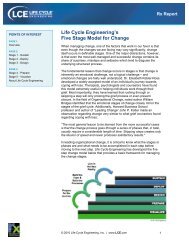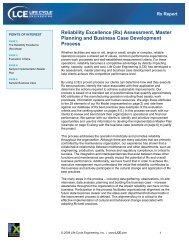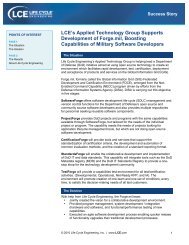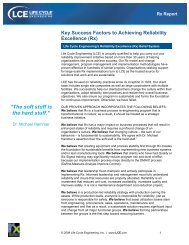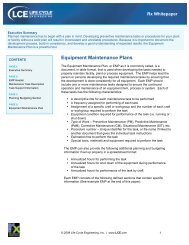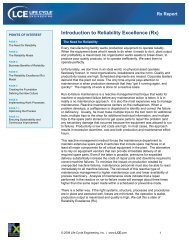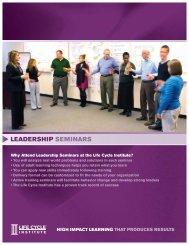Fired Up: Alcoa Smelting Plant Pursues Excellence in Reliability (PDF)
Fired Up: Alcoa Smelting Plant Pursues Excellence in Reliability (PDF)
Fired Up: Alcoa Smelting Plant Pursues Excellence in Reliability (PDF)
You also want an ePaper? Increase the reach of your titles
YUMPU automatically turns print PDFs into web optimized ePapers that Google loves.
"ALCOA ANNOUNCED ON JULY 22, 2005 THAT IT WILL INVEST $330M IN ITS WARRICK,<br />
INDIANA OPERATION MENTIONED IN THIS ARTICLE. ALAN CRANSBERG, PRESIDENT,<br />
NORTH AMERICA PRIMARY METALS, STATED THAT BY REDUCING COSTS AND INCREASING EFFICIENCY<br />
THAT THE WARRICK OPERATION HAS EARNED THE RIGHT TO GROW."<br />
A REPRINT FROM RELIABLE PLANT MAGAZINE - SEPTEMBER - OCTOBER 2005
COVER STORY
BY PAUL V. ARNOLD<br />
If you can’t stand the heat, you<br />
better not seek employment at the<br />
<strong>Alcoa</strong> Primary Metals facility <strong>in</strong><br />
southern Indiana.<br />
Fire-breath<strong>in</strong>g potl<strong>in</strong>es and moltenmetal-filled<br />
crucibles can push the<br />
production floor’s ambient temperature<br />
near triple digits. Heat visibly radiates off<br />
mach<strong>in</strong>ery. Rivulets of sweat trickle down<br />
workers’ cheeks and backs. Frequent breaks<br />
for water and Gatorade are a necessity.<br />
It’s a physically demand<strong>in</strong>g<br />
environment, but the real heat<br />
referenced <strong>in</strong> the first paragraph<br />
relates more to this particular<br />
plant’s position <strong>in</strong> the<br />
alum<strong>in</strong>um smelt<strong>in</strong>g <strong>in</strong>dustry.<br />
This site, part of <strong>Alcoa</strong>’s<br />
massive Warrick Operations,<br />
was constructed <strong>in</strong> the<br />
late 1950s and began<br />
produc<strong>in</strong>g raw<br />
alum<strong>in</strong>um<br />
for the can sheet <strong>in</strong>dustry <strong>in</strong> the early 1960s.<br />
It’s an old plant <strong>in</strong> an age- and technologysensitive<br />
<strong>in</strong>dustry. There were 33 American<br />
smelt<strong>in</strong>g plants operat<strong>in</strong>g <strong>in</strong> 1980. Today,<br />
there are 13. Just 6 percent of the world’s<br />
alum<strong>in</strong>um capacity will be produced this year<br />
at smelters more than 50 years old. The clock<br />
is tick<strong>in</strong>g.<br />
To this state, add <strong>in</strong> that:<br />
• 25 percent of the plant’s workforce is<br />
currently eligible for retirement through<br />
age or years of service;<br />
• wages paid by the plant are among the<br />
highest <strong>in</strong> the <strong>in</strong>dustry; and,<br />
• a few years ago, this smelter’s ma<strong>in</strong>tenance<br />
costs per metric ton of alum<strong>in</strong>um<br />
produced were the second-highest <strong>in</strong> the<br />
global <strong>Alcoa</strong> system.<br />
Can you feel the heat? Every employee at<br />
this plant does. But <strong>in</strong>stead of await<strong>in</strong>g a<br />
demise that seemed imm<strong>in</strong>ent, ma<strong>in</strong>tenance<br />
and operations personnel have<br />
stepped forward and taken action.<br />
“We have to hitch it up if we want to<br />
ma<strong>in</strong>ta<strong>in</strong> this standard of liv<strong>in</strong>g and keep<br />
this plant alive,” says smelt<strong>in</strong>g <strong>Alcoa</strong><br />
Bus<strong>in</strong>ess System manager Mark Keneipp.<br />
“This is the new reality. You just have to<br />
deal with it.”<br />
It starts with a look <strong>in</strong> the mirror.<br />
“Our challenge was and is to be costcompetitive<br />
<strong>in</strong> spite of our old age,” says<br />
Keneipp. “We are not at the front of the<br />
age curve anymore. We must have a 15- to<br />
20-year horizon to attract capital with<strong>in</strong><br />
<strong>Alcoa</strong>. If it is 25 to 30 years, that would be<br />
great. To do that, we have to cont<strong>in</strong>ually<br />
prove ourselves as a lean, cost-competitive,<br />
stable and efficient plant.”<br />
This isn’t an environment for the weak.<br />
But through hard work and perseverance,<br />
there are ample rewards.<br />
CALLING TIME-OUT<br />
Efforts to susta<strong>in</strong> <strong>Alcoa</strong> Primary Metals’<br />
presence <strong>in</strong> the southern Indiana manufactur<strong>in</strong>g<br />
community began at the corporate<br />
level.<br />
In 1997, <strong>Alcoa</strong> CEO Ala<strong>in</strong> Belda began<br />
br<strong>in</strong>g<strong>in</strong>g Toyota Production System (TPS)<br />
pr<strong>in</strong>ciples to his company’s 250 global<br />
locations.<br />
TPS is a lean manufactur<strong>in</strong>g philosophy<br />
built on “just-<strong>in</strong>-time” production, waste<br />
elim<strong>in</strong>ation and rapid problem-solv<strong>in</strong>g.<br />
www.reliableplant.com September - October 2005
Long, narrow aisles and high temperatures<br />
are characteristics of the potl<strong>in</strong>e areas<br />
at the <strong>Alcoa</strong> Primary Metals plant. The<br />
site’s potl<strong>in</strong>es produce 265,000 metric tons<br />
of alum<strong>in</strong>um each year.<br />
Alum<strong>in</strong>um plant production manager<br />
Rodney Cunn<strong>in</strong>gham (left), process coord<strong>in</strong>ator<br />
Larry York and senior staff process<br />
eng<strong>in</strong>eer Brian Audie stand <strong>in</strong>side of a<br />
vacant alum<strong>in</strong>a tank on the grounds of<br />
<strong>Alcoa</strong>’s Warrick Operations. The site traditionally<br />
used four such tanks as hold<strong>in</strong>g<br />
vessels for alum<strong>in</strong>a, a key <strong>in</strong>gredient <strong>in</strong> the<br />
alum<strong>in</strong>um smelt<strong>in</strong>g process. Lean manufactur<strong>in</strong>g<br />
<strong>in</strong>itiatives and critical th<strong>in</strong>k<strong>in</strong>g led the<br />
plant to downsize to two tanks, sav<strong>in</strong>g the<br />
company a large sum of money.<br />
Photos by Photics LLC<br />
JUST THE FACTS<br />
<strong>Plant</strong>: <strong>Alcoa</strong>’s Warrick Operations<br />
consist<strong>in</strong>g of Primary Metals (smelt<strong>in</strong>g)<br />
and Rigid Packag<strong>in</strong>g (fabrication) divisions<br />
<strong>in</strong> Newburgh, Ind.<br />
Employment: Approximately 2,000<br />
(740 PMD, 1,260 RPD).<br />
Square footage: 120 acres under one<br />
roof, 9,000 acres overall.<br />
Products: Alum<strong>in</strong>um sheet for beverage<br />
and foods can ends and tabs, plus<br />
other flat-rolled alum<strong>in</strong>um products.<br />
Production volume: PMD, 265,000<br />
metric tons; RPD, 800 million pounds.<br />
FYI: Site became operational <strong>in</strong> 1960.<br />
However, the Indiana smelter made an<br />
important discovery when implement<strong>in</strong>g<br />
the system.<br />
“TPS and flow and lean don’t work if<br />
you have unstable, unpredictable equipment,”<br />
says Keneipp.<br />
Efficient, streaml<strong>in</strong>ed and cost-effective<br />
plant ma<strong>in</strong>tenance and mach<strong>in</strong>ery reliability<br />
must come first.<br />
To illustrate his po<strong>in</strong>t, Keneipp offers a<br />
diagram called “the ma<strong>in</strong>tenance iceberg.”<br />
Above the water are direct ma<strong>in</strong>tenance<br />
costs l<strong>in</strong>ked to materials, labor, overtime,<br />
contract services, and overhead and benefits.<br />
Under the surface lurk <strong>in</strong>direct costs<br />
tied to downtime, setup and startup,<br />
missed schedules, excess <strong>in</strong>ventory, crisis<br />
management, emergency purchases and an<br />
overall ripple effect on production.<br />
“The <strong>in</strong>direct components are held<br />
hostage by a plant’s unstable equipment<br />
and processes,” he says.<br />
All of this waste gums up the system and<br />
drives up both operations and ma<strong>in</strong>tenance<br />
costs.<br />
In 2002, this smelt<strong>in</strong>g plant had total<br />
ma<strong>in</strong>tenance costs <strong>in</strong> excess of $35 million.<br />
Its “pa<strong>in</strong>fully high” ratio of more than $137<br />
<strong>in</strong> ma<strong>in</strong>tenance costs for every metric ton<br />
of alum<strong>in</strong>um produced (see “Just the facts”<br />
for annual tonnage) placed it second-tolast<br />
among <strong>Alcoa</strong> smelt<strong>in</strong>g plants<br />
worldwide. The global average <strong>in</strong> 2002 was<br />
$90 per metric ton.<br />
This <strong>Alcoa</strong> plant and its leaders had two<br />
options.
General mechanic Dick Day has led organization, standardization<br />
and cost-sav<strong>in</strong>gs <strong>in</strong>itiatives <strong>in</strong> the plant’s centralized tool crib.<br />
Sherman Clark lends a hand as an overhead crane moves a<br />
crucible top <strong>in</strong>to place.<br />
“The plant manager, Royce Haws, said<br />
we were go<strong>in</strong>g to reduce our costs. It was<br />
not an option to stay where we were. It was<br />
go<strong>in</strong>g to happen,” says Keneipp. “We could<br />
either do it the smart way or the shortsighted<br />
way. When you go shortsighted,<br />
those are scary days. It’s tough to attract<br />
capital <strong>in</strong>to the plant to go after the th<strong>in</strong>gs<br />
that need to be done when you just defer<br />
ma<strong>in</strong>tenance. Nobody feels good about<br />
that approach. That’s motivation for folks<br />
to seek someth<strong>in</strong>g better.”<br />
CATCHING THE WAVES<br />
If you haven’t guessed by now, the <strong>Alcoa</strong><br />
plant chose the smart approach to drive<br />
down ma<strong>in</strong>tenance costs. Ma<strong>in</strong>tenance<br />
leaders teamed up with consultants from<br />
Life Cycle Eng<strong>in</strong>eer<strong>in</strong>g (LCE) and the Ron<br />
Moore Group <strong>in</strong> early 2003 to create an<br />
approach called the <strong>Reliability</strong> <strong>Excellence</strong><br />
Process, which was deployed <strong>in</strong> three<br />
“waves.” The process is based on the belief<br />
that a formalized, well-def<strong>in</strong>ed partnership is<br />
imperative between ma<strong>in</strong>tenance and operations.<br />
In this partnership, operations owns<br />
the equipment and has a primary stake <strong>in</strong><br />
reliability. Ma<strong>in</strong>tenance is an equal partner<br />
dedicated to provide timely and effective<br />
methods, skills, expertise and support.<br />
“That’s a big change,” says reliability<br />
eng<strong>in</strong>eer<strong>in</strong>g super<strong>in</strong>tendent Joseph Motz.<br />
“It used to be a silo environment with<br />
plenty of f<strong>in</strong>ger-po<strong>in</strong>t<strong>in</strong>g.”<br />
Some examples:<br />
An operator noticed a potential problem.<br />
No fix was scheduled or made. The<br />
mach<strong>in</strong>e broke down. Who was to blame?<br />
Or, ma<strong>in</strong>tenance showed up for a twohour<br />
preventive ma<strong>in</strong>tenance job. While <strong>in</strong><br />
the mach<strong>in</strong>e, it found additional issues and<br />
f<strong>in</strong>ished the PM job eight hours later, thus<br />
impact<strong>in</strong>g output. Who was to blame?<br />
The answer <strong>in</strong> these cases was both<br />
ma<strong>in</strong>tenance and operations.<br />
“We had to realize we’re all on the same<br />
team,” says Motz. “We’re all here to make<br />
alum<strong>in</strong>um. If we go <strong>in</strong> different directions<br />
and don’t work together, the process<br />
doesn’t work.”<br />
Wave 1 <strong>in</strong> the three-wave approach<br />
began <strong>in</strong> June 2003.<br />
“Wave 1 was Ron Moore,” says<br />
Keneipp. “We brought him <strong>in</strong> to speak<br />
with key plant leaders. He challenged<br />
the age-old paradigms. ‘You need to take<br />
more of an asset-owner philosophy.’<br />
‘You’re wast<strong>in</strong>g money.’ He shakes th<strong>in</strong>gs<br />
up and opens eyes.”<br />
Wave 2 arrived <strong>in</strong> August with a full<br />
<strong>Reliability</strong> <strong>Excellence</strong> assessment by LCE.<br />
Over a two-week period, the firm<br />
conducted lengthy <strong>in</strong>terviews with 90 operations<br />
and ma<strong>in</strong>tenance employees (hourly<br />
and salary), as well as the plant controller.<br />
The <strong>in</strong>formation led to:<br />
1) a f<strong>in</strong>ancial analysis detail<strong>in</strong>g the estimated<br />
value <strong>in</strong> clos<strong>in</strong>g the gaps to<br />
excellence <strong>in</strong> reliability compared to the<br />
implementation cost (presented as a<br />
return-on-<strong>in</strong>vestment calculation);<br />
2) a prelim<strong>in</strong>ary master plan that outl<strong>in</strong>ed<br />
the processes and methodologies required<br />
to close the gaps.<br />
“We wanted to look at our current<br />
condition and identify a target condition,”<br />
says Keneipp. “The gap between those two<br />
is your pa<strong>in</strong> or ga<strong>in</strong>. Is it worth the effort to<br />
bridge the gap? We had to prove that<br />
worth to senior management. We had to<br />
prove there were merits <strong>in</strong> putt<strong>in</strong>g money<br />
<strong>in</strong>to the old plant.<br />
“Faced with all the facts, it was prudent<br />
to get money approved as soon as possible<br />
to proceed.”<br />
Wave 3 began <strong>in</strong> September. Operations<br />
and ma<strong>in</strong>tenance leaders:<br />
• implemented the master plan<br />
• educated all employees on their new roles<br />
and responsibilities related to <strong>in</strong>creas<strong>in</strong>g<br />
equipment reliability<br />
• conducted workshops on proper reliability-enhancement<br />
techniques<br />
• established def<strong>in</strong>ed processes and effective<br />
measures of progress<br />
“This isn’t easy. None of this stuff is,”<br />
says potroom production manager Rodney<br />
Cunn<strong>in</strong>gham. “But if you have management<br />
commitment and a partnership<br />
between ma<strong>in</strong>tenance and operations,<br />
your chances of success <strong>in</strong>crease. Without<br />
those th<strong>in</strong>gs, you aren’t go<strong>in</strong>g to make it.”
RAISING THE BAR<br />
Establish<strong>in</strong>g def<strong>in</strong>itions <strong>in</strong> a variety of<br />
areas have helped trigger improvements. A<br />
primary focus was to def<strong>in</strong>e “what is<br />
possible?” and “what is progress?”<br />
An answer came <strong>in</strong> accept<strong>in</strong>g overall<br />
equipment effectiveness (OEE) as a key<br />
plant-wide metric. OEE tracks sources of<br />
operat<strong>in</strong>g loss, <strong>in</strong>clud<strong>in</strong>g equipment availability,<br />
performance and quality, and is<br />
expressed as a percentage of optimum<br />
performance.<br />
“It’s basically def<strong>in</strong>ed by some past<br />
best performance,” electrode production<br />
manager Tom Svoboda. “You saw it<br />
happen. It wasn’t fictional or hypothetical.<br />
Whether the equipment was runn<strong>in</strong>g<br />
extraord<strong>in</strong>arily that month or you were<br />
really on top of the process, it happened.<br />
The question is, if you did it dur<strong>in</strong>g that<br />
one period of time, why can’t you do it<br />
all the time?”<br />
Us<strong>in</strong>g a sports analogy to illustrate the<br />
importance of 100 percent OEE, if a high<br />
jumper normally jumps 6 feet 6 <strong>in</strong>ches but<br />
establishes a personal best of 7 feet, what<br />
specifically led to this peak 100 percent<br />
performance. Did he tra<strong>in</strong> differently? Did<br />
he change his diet prior to the meet? Did he<br />
wear different shoes? He literally raised the<br />
bar. What can be learned and what can be<br />
done to achieve that mark time and aga<strong>in</strong>?<br />
Ma<strong>in</strong>tenance and operations worked<br />
together to def<strong>in</strong>e peak performance for<br />
plant functions (for example, anode<br />
assembly), processes (ore unload<strong>in</strong>g),<br />
outcomes (scrap) and <strong>in</strong>dividual pieces of<br />
equipment (r<strong>in</strong>g furnace). In compil<strong>in</strong>g this<br />
<strong>in</strong>formation, it was determ<strong>in</strong>ed that $8.3<br />
million <strong>in</strong> annual cost sav<strong>in</strong>gs were possible<br />
as the result of achiev<strong>in</strong>g OEE goals.<br />
With the background <strong>in</strong>formation,<br />
current states were def<strong>in</strong>ed and target<br />
conditions established. Activities – work<br />
projects utiliz<strong>in</strong>g lean manufactur<strong>in</strong>g<br />
tools such as kaizen and Cont<strong>in</strong>uous<br />
Improvement – took place. Progress was<br />
measured and analyzed. And, tangible<br />
benefits were calculated.<br />
In 2004, $2.4 million <strong>in</strong> improvements<br />
were l<strong>in</strong>ked to OEE ga<strong>in</strong>s.<br />
Look<strong>in</strong>g deeper and tak<strong>in</strong>g actions also<br />
led to decreased ma<strong>in</strong>tenance expenses <strong>in</strong><br />
the smelt<strong>in</strong>g plant. In the first year after<br />
beg<strong>in</strong>n<strong>in</strong>g the reliability <strong>in</strong>itiative, expenses<br />
dropped $1.9 million, from a basel<strong>in</strong>e<br />
figure of $32 million to $30.1 million. In<br />
2004, the figure fell another $700,000.<br />
The ratio of ma<strong>in</strong>tenance expenses per<br />
metric ton produced also dropped to $109<br />
<strong>in</strong> 2004.<br />
THE PLAN ON ‘PLANNED’<br />
A major effort also was made to better<br />
def<strong>in</strong>e elements of ma<strong>in</strong>tenance. Specifically,<br />
<strong>in</strong> this operator-led reliability system, “how<br />
does work get planned?” and “how does<br />
work get done?”<br />
“Look<strong>in</strong>g back, we were fool<strong>in</strong>g<br />
ourselves <strong>in</strong>to th<strong>in</strong>k<strong>in</strong>g that we were<br />
healthy,” says ma<strong>in</strong>tenance manager<br />
Danny Reyes. “Many of our old metrics<br />
were out of touch. We thought our<br />
‘percent planned and scheduled work’ was<br />
at 85 percent and our ‘percent PM completion’<br />
was at 90 percent.”<br />
LCE <strong>in</strong>formed the plant that it was us<strong>in</strong>g<br />
the wrong def<strong>in</strong>itions.<br />
“The ‘percent planned and scheduled<br />
work’ was really just ‘percent scheduled.’<br />
Plann<strong>in</strong>g was very limited,” Reyes says. “It<br />
was schedule compliance. Probably 10<br />
percent of those jobs were planned.”<br />
WHAT ARE THE<br />
CHARACTERISTICS OF<br />
A PLANNED JOB?<br />
1) There is an accurate time estimate for<br />
the job such that the supervisor would<br />
have a reasonable expectation on<br />
when he or she could assign the task.<br />
2) There is an accurate estimate of<br />
needed resources <strong>in</strong> terms of crafts<br />
personnel, repair/replacement parts,<br />
tools, support equipment, etc.<br />
3) All necessary <strong>in</strong>formation (bluepr<strong>in</strong>ts,<br />
permits, safety-related, etc.)<br />
is obta<strong>in</strong>ed.<br />
4) Job step sequence, procedures and<br />
<strong>in</strong>structions to accomplish the work<br />
are established.<br />
5) All needed parts and materials are<br />
kitted.<br />
6) As a built-<strong>in</strong> check to assure a quality<br />
planned job, periodically discuss the<br />
nature of the job with a supervisor<br />
and/or the craftsperson assigned to<br />
complete the job. Assure there is a<br />
full understand<strong>in</strong>g of the scope of<br />
work and that the kitted job package<br />
is complete.<br />
A 35-to-1 ratio of crafts personnel (140)<br />
to planners (four) was the crux of the<br />
problem.<br />
“It did not work very well,” says<br />
ma<strong>in</strong>tenance planner Larry McCubb<strong>in</strong>s.<br />
“There was very little time to plan. You<br />
became a scheduler, and not a very good<br />
one at that.”<br />
A reactive environment thrives <strong>in</strong> this<br />
sett<strong>in</strong>g. “We were do<strong>in</strong>g the ‘home ma<strong>in</strong>tenance<br />
approach,’” says Keneipp. “That’s<br />
the way you and I tackle projects on a<br />
Saturday morn<strong>in</strong>g. It’s really unplanned<br />
and <strong>in</strong>efficient.”<br />
The plant has s<strong>in</strong>ce added three planners<br />
for a total of seven, provid<strong>in</strong>g a more<br />
manageable ratio of 20-to-1.<br />
“That makes it possible for these guys to<br />
set up, organize work, plan it, schedule it<br />
out with production centers, make sure all<br />
the parts are there, make sure the equipment<br />
is down and the time is allotted,” says<br />
smelt<strong>in</strong>g ma<strong>in</strong>tenance super<strong>in</strong>tendent<br />
Scott Deon.<br />
Other keys to better plann<strong>in</strong>g:<br />
1)A formal document now outl<strong>in</strong>es the<br />
components of a planned job.<br />
“The poor four planners we had try<strong>in</strong>g to<br />
do everyth<strong>in</strong>g didn’t do th<strong>in</strong>gs the same<br />
way,” says Deon. “This new format now<br />
standardizes how to perform the work.”<br />
2) A formal, secure area is now used by the<br />
planners for job kitt<strong>in</strong>g. In the past,<br />
needed parts and materials were<br />
dispatched piecemeal to a job site. The<br />
pile might sit for weeks until all items<br />
arrived. Dur<strong>in</strong>g the wait<strong>in</strong>g time, it was<br />
not uncommon for parts or tools to be<br />
moved, lost or used for another job.<br />
“As the planner plans the job, he orders<br />
all the materials and has them delivered<br />
here,” says McCubb<strong>in</strong>s. “When everyth<strong>in</strong>g<br />
for the job is here, we gather it on a pallet<br />
or two. The crafts then come and take it<br />
out to the job site and perform the work.”<br />
3) Effective communication.<br />
“I used to th<strong>in</strong>k that I knew what people<br />
wanted. This process taught me that I<br />
didn’t,” says McCubb<strong>in</strong>s. “I didn’t know<br />
what they wanted and what was right for<br />
them. In the past, I planned the job and<br />
didn’t ask questions.”<br />
Adds Deon: “With the shared responsibility<br />
with production, we now know which<br />
job comes first. The person who owns the
equipment should know what the most<br />
critical th<strong>in</strong>g is. Before, I don’t th<strong>in</strong>k we<br />
were guess<strong>in</strong>g. But were we 100 percent?<br />
Probably not.”<br />
4) Focused, effective weekly meet<strong>in</strong>gs.<br />
“Asset owners chair the meet<strong>in</strong>gs and<br />
area ma<strong>in</strong>tenance planner/schedulers are<br />
facilitators,” says Keneipp. “If it’s a plann<strong>in</strong>g<br />
meet<strong>in</strong>g, we discuss how we’re go<strong>in</strong>g<br />
to do this. If it’s a schedul<strong>in</strong>g meet<strong>in</strong>g, we<br />
establish the schedule.”<br />
Also <strong>in</strong> regard to how work gets done, the<br />
plant took steps to document equipment<br />
history and to standardize ma<strong>in</strong>tenance<br />
task <strong>in</strong>structions.<br />
“In the early days, you could get records,<br />
but then the documentation stopped,”<br />
says rectifier station power eng<strong>in</strong>eer Dan<br />
Decastra. “So, we created a location on the<br />
server and began document<strong>in</strong>g. For this<br />
station, we created a ‘bad boy’ list. We<br />
picked out the big issues and started there.<br />
Now, you can go back to 2001 and see a<br />
history on the air switches, contacts, transformers<br />
and the skids.”<br />
Adds reliability eng<strong>in</strong>eer Jonathan<br />
Fulton: “Maybe one-third of our ma<strong>in</strong>tenance<br />
workforce could retire tomorrow if<br />
they wanted. That’s a huge potential<br />
liability for us. And, it’s hard to get a quality<br />
craftsperson from the outside. To address<br />
this, we are standardiz<strong>in</strong>g work processes<br />
and develop<strong>in</strong>g equipment history. By<br />
do<strong>in</strong>g this, we can get people with technical<br />
expertise up to speed <strong>in</strong> a hurry.”<br />
CRIB NOTES<br />
A f<strong>in</strong>al improvement example is how the<br />
plant better def<strong>in</strong>ed who buys ma<strong>in</strong>tenance<br />
products and how money is spent<br />
for tools and consumable-type materials.<br />
In the past, assorted ma<strong>in</strong>tenance<br />
personnel <strong>in</strong> the smelt<strong>in</strong>g plant bought the<br />
hand tools, power tools, safety products,<br />
cleaners, material handl<strong>in</strong>g products and a<br />
hundred other needed items. Purchased<br />
products were housed at decentralized tool<br />
cribs around the facility and <strong>in</strong> a host of<br />
non-official hold<strong>in</strong>g spots (lockers, chests<br />
and cubby holes).<br />
“As the plant kept expand<strong>in</strong>g, areas were<br />
added. They had a little group and somebody<br />
did the order<strong>in</strong>g and they’d pool their<br />
supplies here and there,” says general<br />
mechanic Dick Day. “We were spend<strong>in</strong>g a<br />
large amount of money try<strong>in</strong>g to feed these<br />
Molten metal is poured from a crucible <strong>in</strong> the Ingot Department of the <strong>Alcoa</strong> plant.<br />
satellite cribs. They weren’t managed. People<br />
bought stuff, but it wasn’t really accessible.”<br />
If a mechanic needed a particular tool,<br />
he’d hunt for it. It was around somewhere.<br />
If he couldn’t f<strong>in</strong>d it, he’d order one. That<br />
purchased tool might disappear before it<br />
got to him. It led to wasteful and redundant<br />
spend<strong>in</strong>g.<br />
To address this, a centralized crib was<br />
constructed and all satellite crib and cubby<br />
hole items were brought <strong>in</strong>to this secure,<br />
gated area.<br />
In came the worthless.<br />
“We realized we had a lot of obsolete<br />
stuff – someth<strong>in</strong>g for a piece of equipment<br />
we may have taken out 10 years ago,”<br />
Keneipp says.<br />
And, <strong>in</strong> came the valuable.<br />
“It was amaz<strong>in</strong>g all that came out of the<br />
woodwork. Someone brought a cab<strong>in</strong>et<br />
over with more than $38,000 of pumps<br />
and jacks <strong>in</strong> it,” says Day, who became the<br />
central crib’s ma<strong>in</strong> attendant. “We started<br />
us<strong>in</strong>g what we had. For some materials, we<br />
didn’t have to order anyth<strong>in</strong>g for a year.”<br />
Today, Day is responsible for buy<strong>in</strong>g<br />
these ma<strong>in</strong>tenance-related products. He<br />
receives the purchases, stores the items and<br />
dispenses them as needed.<br />
“We know what we have and where it is<br />
located,” he says.<br />
Day also has created a m<strong>in</strong>imum/<br />
maximum system for a variety of products<br />
and embarked on efforts to standardize<br />
brands of power tools and weld<strong>in</strong>g supplies.<br />
“With power tools, we have standardized<br />
mostly on DeWalt, and we are gett<strong>in</strong>g<br />
heavily <strong>in</strong>to their cordless tools,” he says.<br />
“For weld<strong>in</strong>g supplies, we have standardized<br />
our wire feed guns and the replacement<br />
parts for those guns.”<br />
He does his homework and f<strong>in</strong>ds <strong>in</strong>novative<br />
ways to cut costs.<br />
A few examples are:<br />
Gloves: “We used to buy a brand of<br />
gloves that had a little tab on it for $12 a
pair. That’s what everybody ‘had to have,’”<br />
he says. “You could buy the same gloves<br />
with a little elastic <strong>in</strong> it for $2.67 per pair.<br />
People liked them.”<br />
Hydraulic oil: “We bought it by the<br />
gallon at $8 a pop. Buy<strong>in</strong>g it <strong>in</strong> bulk, we<br />
now save $3 per gallon. I pour the oil <strong>in</strong>to<br />
reusable jugs that cost 57 cents apiece.”<br />
Acetylene hose: “We used to buy it<br />
prepackaged <strong>in</strong> a spool. Now, we buy it on<br />
a 500-foot roll and cut off what the person<br />
needs. We save 25 percent.”<br />
Day says it’s all common sense.<br />
“I look at it as my money,” he says. “If<br />
this is my bus<strong>in</strong>ess, this is how I’d run it.”<br />
MAKING THEM SWEAT<br />
Through hard work, partnership, ownership<br />
and <strong>in</strong>novative th<strong>in</strong>k<strong>in</strong>g, this <strong>Alcoa</strong><br />
smelt<strong>in</strong>g plant has become more stable,<br />
lean, predictable, reliable and cost-competitive.<br />
OEE cost benefits are $4.4 million annualized<br />
for 2005 year-to-date compared to<br />
the 2003 basel<strong>in</strong>e figure.<br />
2005 year-to-date ma<strong>in</strong>tenance expenses<br />
are $27.1 million annualized and reflect a<br />
$4.9 million decrease from the 2003 basel<strong>in</strong>e<br />
number.<br />
Ma<strong>in</strong>tenance costs for the second<br />
quarter of 2005 were $96 per metric ton<br />
produced and sights are set for achiev<strong>in</strong>g<br />
$87 <strong>in</strong> the near future.<br />
An LCE follow-up assessment put the<br />
plant <strong>in</strong> the “proactive conditions” category<br />
and work is under way to elevate <strong>in</strong>to<br />
the “excellence” category.<br />
There is optimism and momentum.<br />
“When I was hired 15 years ago, we said,<br />
‘We’re old technology. We can’t compete<br />
with some of the more modern facilities,’”<br />
says Fulton. “For me, the reward is see<strong>in</strong>g<br />
us compete and have higher efficiency. We<br />
are produc<strong>in</strong>g better with our 40- or 50-<br />
year-old technology than at sites built 10 or<br />
20 years ago.”<br />
While the heat won’t ever completely go<br />
away for this plant, it is do<strong>in</strong>g what it can<br />
to make the competition sweat.<br />
Call 800.556.9589 or visit www.LCE.com



